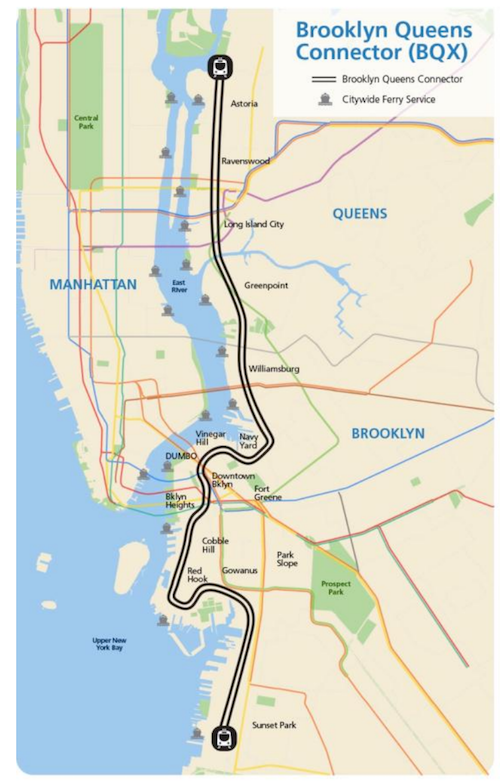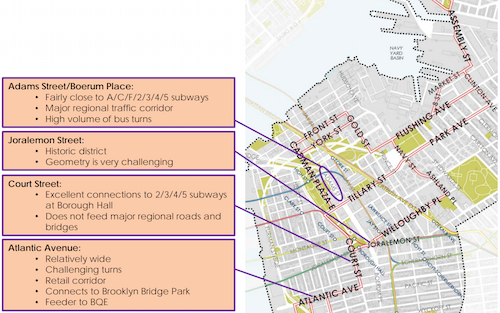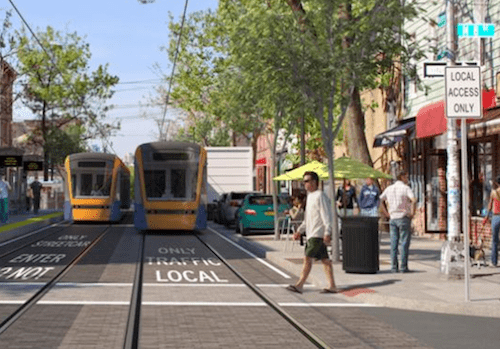Despite a hard sell and continued support of developers, some city planners and de Blasio allies, the proposed $2.5 billion Brooklyn Queens Connector (BQX) linking the Brooklyn Queens East River waterfront from Sunset Park to Astoria continues to face logistical resistance on how exactly it will run through the heart of bustling Downtown Brooklyn and worries it will serve to displace rather than help low-income residents that live along the corridor.

According to the plan, the BQX will start in Sunset Park and will run through Gowanus, Red Hook, Cobble Hill, Brooklyn Heights, Downtown Brooklyn, DUMBO, Vinegar Hill, The Navy Yard, Williamsburg, Greenpoint before heading to Long Island City and ending in Astoria. The route is 16-miles long along the East River waterfront corridor and is planned to run 24-hours-a-day at 5 minute intervals at peak hours. The stops are planned to be ½ mile apart according to its website.
The BQX was announced back in February of this year and was followed by seven “visioning sessions” over the summer in which members of the affected communities were invited by the New York City Economic Development Corporation (NYCEDC) to meetings that would explain the streetcar system and its impact to the community. At these sessions community leaders and advocates were able to voice their concerns and express their fears over the new project.
One such dissenting voice is UPROSE, Brooklyn’s Oldest Latino based organization out of Sunset Park. “It doesn’t address the transportation needs of the people in the corridor, who have been in need of transportation services for many years. Transportation in this corridor did not become a priority until people started getting displaced and developers determined for our community that it was a priority to them,”said UPROSE Executive Director Elizabeth Yeampierre.
“This area could really be interesting, different and innovative and serve a lot of the needs of the local people and the region. Unfortunately, the political world is more aligned with the needs of the developers than the needs of the people in this corridor,” she added.
Another concern is the BQX transit system is not going to be a part of the MTA transit system. As a result, the BQX will charge it’s own fare independent of the regular MTA bus and train system.
“The mayor gets cute by saying the BQX will have the same price as a subway ride, which would be nice if you live in Williamsburg and work in Industry City in Sunset Park, but NYCHA residents that live in the Red Hook Houses would be paying $2.75 to get on the trolley and another $2.75 to get on the subway for a $5.50 commute to work,” said one veteran Community Board 2 source, which covers both the Downtown, Brooklyn Heights, Vinegar Hill and Fort Greene portion of the BQX.
But a City Economic Development Corporation (EDC) spokeswoman said that while working with the MTA to have a fully integrated fare system continues to be a priority, that won’t happen until the end of the process.
“Right now we’re focused on completing our BQX study, which will take us closer to bringing fast, modern and accessible streetcar service to transit starved communities,” the spokeswoman said.
Recently, five NYCHA Associations showed their support for the new transit project, which included Presidents of the Red Hook East and Ingersoll Houses in Brooklyn. The new support was welcomed by the Friends of the BQX, a non-profit/lobbying organization that is made up of an array of city developers, several of whom own propoerty along the BQX corridor, and several orgnaization that do business with the city, along with transportation advocates long allied with Mayor Bill de Blasio, who strongly support the project.
“These local leaders know first-hand the challenges a community cut-off from reliable transit access faces, where it’s difficult to get to jobs, school, medical appointments, or frankly anywhere you want to go,” said Ya-Ting Liu, executive director of the Friends of the BQX. “I look forward to working with the new board members to ensure that all New Yorkers have a voice in bringing better transit to our City.”
The BQX also has somewhat divided support among the two Brooklyn City Council Members, Stephen Levin and Carlos Menchaca, in whose districts the Trolley would run through. Both recently appeared on a NY1 television show on the project.
Levin, who along with Brooklyn City Council Member Brad Lander, has already pledged support to de Blasio for re-election next year, said the BQX has real potential benefits as the Williamsburg/Greenpoint end of his district has been significantly rezoned and developed in last five years.
“Public transportation never caught up to that developement. I have a lot of constituents working in Downtown Brooklyn and who live in Williamsburg,” said Levin, adding the only alternative for them is either the G train that run through Queens and Brooklyn or the East River Ferry, but neither is fully effective.
Menchaca said while there is a real cry for better public transportation, he has deeper questions of how the trolley line connects to rising rents in such heavy working-class Chinese and Hispanic immigrant neighborhoods such as Sunset Park. He also noted there was a lack of outreach to these communities to get their input on the project.

Another major concern is that the city is still deciding on the best route for the BQX, particularly through the Downtown Brooklyn corridor as cutting through Brooklyn Bridge Park is out of the question due to major structural renovation work being done on the Brooklyn Queens Expressway cantilever running beneath the Montague Street promenade.
The four proposed routes are: Adams Street/Boerum Place, Joralemon Street, Court Street and Atlantic Avenue. The four routes were recently presented before both the CB2 Transportation committee and the Atlantic Avenue BID (Business Improvement District).
“They don’t have a route figured out at all,” said the CB2 source. “They talked some crazy stuff about running it down Cadman Plaza East in front of the Federal Courthouse [and in front of the Office of Emergency Management Building] both high security sites.”
Several BID members also explained how taking away lanes along the Atlantic Avenue corridor will become a nightmare for small businesses that need lanes for deliveries.
The project is planned to break ground in 2019 and have an opening day some time in 2024 according to the EDC website.






